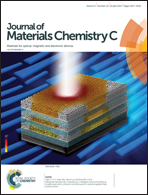Understanding photophysical properties of chiral conjugated corrals for organic photovoltaics†
Abstract
Recently, a chiral conjugated macrocyclic compound containing alternately arranged donor and acceptor motifs exhibited unique advantages (i.e. high absorption coefficient, broad absorption range, and high electron mobility) in organic photovoltaics (OPVs). Understanding the structure–property relationship at the microscopic level is a prerequisite for further performance optimization or improvement. Here, we employed time-dependent density functional theory (TDDFT) to investigate the electronic circular dichroism (CD), UV-vis absorption, charge transport, and second-order nonlinear optical (NLO) properties of the four chiral compounds. The experimental UV-vis/CD spectra of compound 1 were well reproduced by our calculations and could be used to assign the electron transition properties and absolute configuration (AC) with high confidence. The electronic absorption spectra, charge transport properties, and open circuit voltage of compound 1 in OPVs have been rationalized by comparing cyclic and acyclic structures. The designed compounds 2–3 are expected to exhibit excellent performances in OPVs in view of their small energy gaps, large oscillator strengths, and smaller electron reorganization energies. Moreover, the first hyperpolarizability (βtot) of compound 4 is 27 times larger than that of P-nitroaniline. Thus, our studied compounds are also excellent candidates for second-order NLO materials.



 Please wait while we load your content...
Please wait while we load your content...